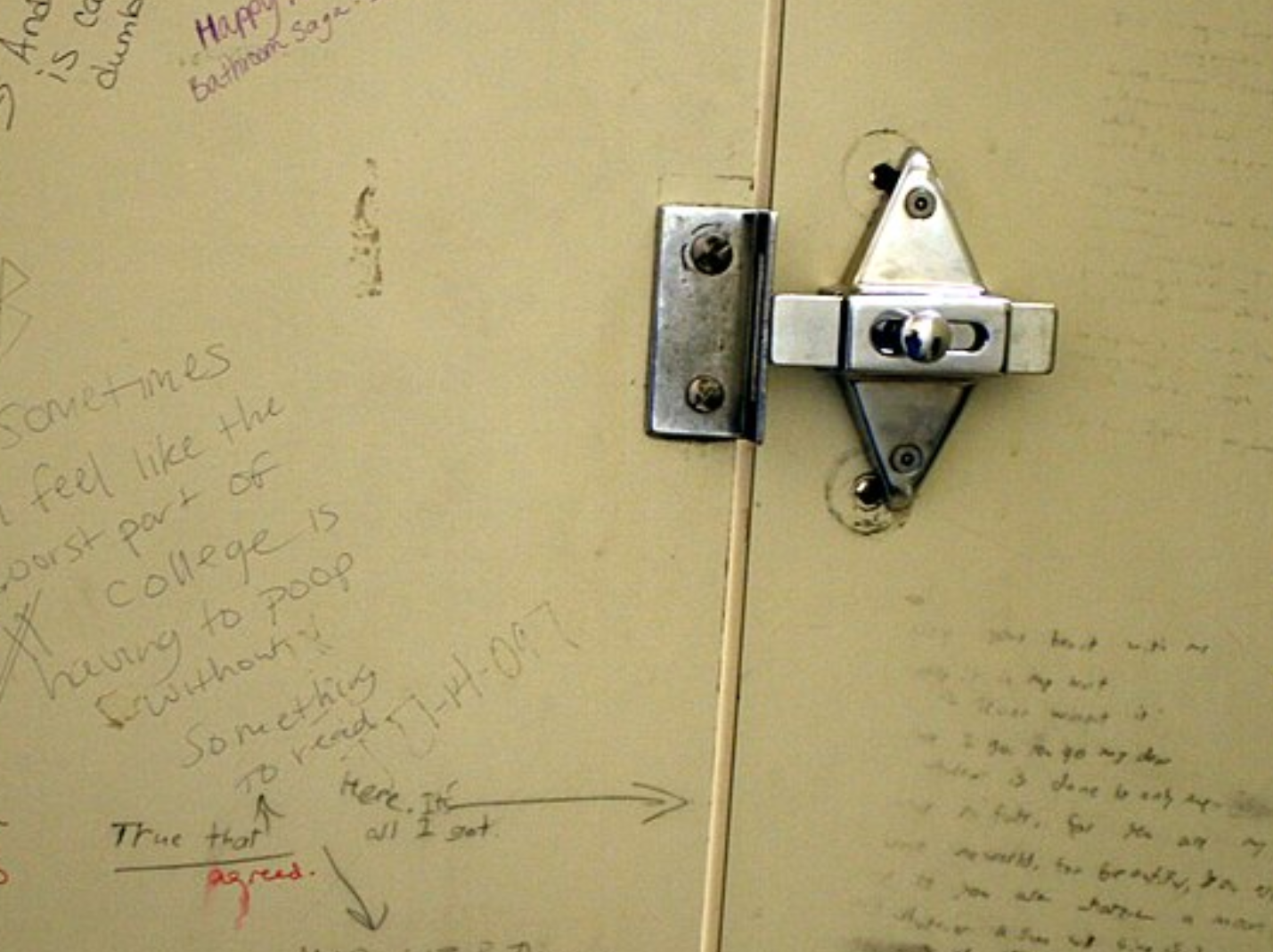
Author’s Note: This article is from my weekly “Top of Mind” email, sent to subscribers every Thursday. For more content like this and to receive the full newsletter each week, enter your name and email under “SIGN UP FOR OUR WEEKLY NEWSLETTER, ‘TOP OF MIND,’” located on the right-hand side of the site.
Liam Rappleye didn’t come to the University of Michigan for glory, prestige, or academic enlightenment. He came for something more sacred: a decent bathroom.
Having transferred from Albion College—a small school where he once treated a hidden bathroom like a personal therapist—Rappleye was plunged into the toilet underworld of a massive public university. He began his quest with the standard facilities: Mason Hall and Hatcher Graduate Library, which, he described, as just downright terrible. Then there was Lorch Hall, which tried to cook him alive. The Modern Languages Building? Full of long lines and urinal lawlessness—only two urinals with no divider between.
Only the urinals in the Law Library had any respect for human dignity. “[I]f there is one bathroom that navigates urinal law perfectly, it would be, of course, the Law Library,” he noted. “The urinals are contained by concrete dividers. They are as aesthetically pleasing as they are practical. The stalls are many and private. It is not the best, but it earns two thumbs up.”
But Rappleye wasn’t just looking for cleanliness. He wanted comfort, quiet, maybe even a little dignity. West Hall came close—with its calm atmosphere and soft-pink tiles—but still felt like a halfway point. Rackham Hall raised the bar, as the materials alone were probably “worth [his] tuition,” but it was almost too polished, more museum than restroom.
Then he stumbled upon something unexpected: a tucked-away bathroom behind an unmarked door. It had a chair, a potted plant, and natural light. He didn’t even use it, but he left feeling lighter. And, sadly, he didn’t share its location.
[RELATED: Should We Believe Whatever a Woman Says About Sexual Assault?]
Rappleye’s journey through the university’s toilet underworld is funny, yes—but it also reveals a frustrating truth about college and university bathrooms: for all the talk we’ve had in recent years about men in women’s bathrooms and the ensuing debates about privacy and dignity, we haven’t asked more basic questions: are campus bathrooms even usable? Are they built to preserve dignity? Do they offer privacy?
To answer that, let’s start with Sadie Naughton. In 2020, she was a Ball State University freshman who said, “Community bathrooms are possibly the hardest part about living in college dorms.” Dirty floors, broken fixtures, inconsiderate neighbors—these are the conditions students across the country face daily.
Aside from maintenance, American college bathrooms are often designed with strange architectural gaps: between stall doors and frames, between the floor and the stall, between your dignity and the next person’s line of sight.
Rappleye said of the Mason Hall bathroom that the “stall doors on the third floor are so low that when I stand up, my entire head and chest rise above them … anyone taller than 5 1/2 feet tall can easily look in and sneak a peek at me on the toilet.”
Some Reddit users tried to justify bathroom stall designs, writing that the gaps make for easier cleaning, emergency access, flood prevention, and that it saves money. But for most students, these so-called money-saving features just feel like design failures—and a complete lack of effort. Many stuff toilet paper into the stall gaps in a last-ditch effort to prevent their classmates—or worse, their professors—from glimpsing the least flattering angle of their undergraduate experience.
Some schools have it worse than others. At Texas State University, student Leona Salinas said, “it’s not uncommon to find entire bathrooms taped off for weeks … the stalls often don’t lock, soap dispensers are broken, and the mirrors are cracked.”
And some institutions offer downright disrespectful bathroom experiences: “At the university I go to, the toilet paper only gives you one sad square at a time, and it’s so thin it feels offensive,” Reddit user, mildlyinfuriating, wrote.
Terrible bathrooms—and terrible supplies—aren’t just signs of a university’s poor infrastructure, but a reflection of their misplaced priorities. Claire Harrington, who attended Liberty University, considered herself fortunate because “Liberty prioritized cleanliness and restroom upkeep,” but other universities, she told me, “with far more federal funding allocate money toward flashy, specialized experiences rather than to [bathrooms,] an essential, unavoidable part of student life.” She’d gladly trade amenities like rock walls or infinity pools for functioning stall doors and stocked toilet paper.
Likewise, Gabrielle, a former graduate student teaching assistant at Baylor University, told me that “Most colleges pride themselves on the ‘experience’ with rock climbing walls or lavish pools but have facilities in desperate need of updating—particularly the facilities.” She added, “if we’re going to invest in capital projects, let’s renovate bathrooms for students and faculty!”
And some are trying to make renovations—just not quickly.
While at Oxford College—Emory’s original campus in Oxford, Georgia—Alyza Harris reported on the deteriorating conditions in the Jolley Residential Center (JRC), a dorm widely considered one of the worst on campus. In her article for the Emory Wheel, she described broken toilets, stifling humidity, and handicap-accessible bathrooms closed for days or even weeks. “The university said it planned to renovate the building by the summer of 2026,” Harris told me, but as far as she knows, nothing’s happened.
Institutions aren’t the only ones to blame. Between renovation delays, broken fixtures, and bathroom layouts that defy dignity, students often return the favor by failing each other.
Vandalism is routine. In late 2021, Gettysburg College racked up thousands in bathroom damages after a spree of destruction. At SUNY Cortland, students—or perhaps just one—etched racial slurs and swastikas into stall doors. If students won’t respect the space, why should the administration invest in it?
And anyone who’s lived in a dorm knows the unique horror of opening a stall door to discover the aftermath of someone’s hangover. The prevailing attitude? “Maintenance will deal with it.”
One essay posed the scenario plainly: if you puke in a dorm bathroom, do you (A) walk out and leave the mess, (B) flush and still leave it, or (C) clean it up like a normal person? At home, most choose C. At school, far too many go with A. That’s not just gross—it’s disrespectful. Custodians aren’t students’ parents. They’re professionals doing thankless work. As one Temple University custodian put it: “All we want is respect.”
And respect, like hygiene, is contagious.
[RELATED: The Battle Over Pronouns Coming to a College Near You]
We already know—from countless consumer surveys and workplace reports—that people take better care of spaces that feel cared for. The same principle applies here: if institutions show they value students—through clean stalls, working locks, stocked soap, and yes, dividers between urinals—students might be more likely to value their environment. If students feel like their daily needs are considered—especially when they’re paying all that tuition—they may be more inclined to consider the needs of others. And when dignity is designed into daily life, it becomes harder to ignore—or defile.
As I said at the beginning of this essay, dignity and privacy are words we’ve used frequently in recent years when talking about college and university bathrooms. But because we’ve spent so much time fighting the absurd issue of keeping men out of women’s bathrooms, we’ve lost sight of a more basic problem: many campus bathrooms aren’t just unusable—they’re not designed to preserve privacy, and they certainly don’t protect dignity.
Cracked stalls, broken locks, and gaps wide enough to make eye contact with strangers aren’t just annoying—they’re dehumanizing. If we simply built bathrooms with floor-to-ceiling walls, functioning locks, and doors that actually close, we’d solve many bathroom problems immediately.
Though crude, Rappleye rightfully says, “Few things in this world are as concrete as bodily waste.” So perhaps it’s time the spaces we use to deal with it reflected that same level of reliability.
Follow Jared Gould on X.
Image: “Hutch first floor women’s bathroom” by Quinn Dombrowski on Wikimedia Commons

It’s really simple: Students are increasingly considered a fungible resource to be exploited. Few would think of looking in the bathrooms to judge a prospective school (prospective K-12 teachers who are smart ALWAYS do) and once they are on campus, sucks to be them.
Gay activists have also been a problem, in Northampton (MA), they have had to cut two feet off the top and bottom of exterior doors. It’s really disgusting — I don’t care what you want to do or how many people you want to do it with, but get a room to do it in…
At my university, in one of the older buildings, one of the restrooms displayed an old, faded, placard that said “Faculty Men”… from a bygone age when faculty and students were appropriately segregated and dignity preserved.
That’s actually in the Massachusetts State Building Code for K-12 schools…
Surely this is satire.
Liam Rappleye. Transfer student “plunged into the toilet underworld of a massive public university.” This is pretty good!
But I have to say — I’ve spent very little time at U Mich — but the mid-level “flagship” campus where I toil is not like described in this little literary production. At least in the science areas, perhaps because of those profligate overhead expenditures, things are not so bad in the restroom department.
Now that fewer or none foreign students will be subsidizing things — now that indirect costs are going to be slashed — now that fewer office staff will be around to deal with campus facilities — perhaps this island of bliss will go the way of U. Mich.
The article mentions federal funding. One would think that funding for bathrooms would not be a federal responsibility.
But when the federal research is cut drastically, as planned by Trump; and if this results in cuts in funding for restrooms in buildings that contain research labs — don’t complain! Or maybe send a message to Mar-A-Lago. I doubt that they have this problem.
Please note, while I expect that facilities like offices, facilities related to research, are probably part of overhead charges to grants — I don’t know anything at granular scale about restrooms.